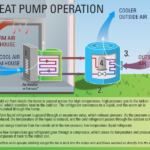Variable Frequency Drive Pool Pumps Energy Efficiency Analysis
Energy Disrupter
While HVAC gets a majority of the attention for those of us who look at home energy use, the pool pump deserves its share of the blame as a major energy hog. Energy Star says that if every pool pump in the U.S. were ES certified, families would save $770 million in energy costs per year and the equivalent of removing 1 million internal combustion engine cars from the road. With that in mind, I’m going to dive in to look at replacing a pool pump with a variable frequency drive (VFD) pump, and see how the equation lines up.
Many pumps are still made with just one speed. This speed needs to handle the main job of a pool pump – cleaning and recirculating water. So if you have a large pool and you want to recirculate all the water in that pool twice a day, those are variables (size and turnover rate) that help a pool professional size the pump. The pump speed is often much higher than is needed to do that job, and rather than having multiple speeds for different jobs (cleaning requires a higher speed than filtering, for instance), the pump continues at its one speed, and a throttle switch moderates the effect for the intended use. That means that the pump is still using the same amount of electricity…it’s like driving with one foot pressing down the accelerator and one pressing the brake, rather than just laying off the accelerator pedal a little bit. The savings come from the filtering, the most common job of a pool pump. Filtering requires half the flow of cleaning, but it uses just 1/8 the electricity, according to Energy Star.
A common 1.5 horsepower pool pump, according to INYO Pools, generally uses about 2140 watts when in use. Multiply that by 8 hours per day, is 17.1 kWh. At our rates here in Hawaii, that is $6 a day, roughly, or about $2,200 per year.
Timers
Now, if your pool pump was set up by a less-than-qualified pool tech, and just runs 24/7, you might just consider adding a timer to cut the pump time down to 6-8 hours a day. Right there, you’re saving 66-75% of the electricity you’re using. So that’s the first thing to check. The second is whether it can find the right gear. From the example above, if that same pump is on 24/7, you’re looking at $6,600 per year.
Variable Frequency Drive
VFD pumps are not new, but the industry has been slow to change, with regulations from the 1920s and antiquated health code laws still dictating much of how the industry runs. This means that pool professionals that get training are still getting training in some archaic technology. However, there are signs the VFD is becoming the preferred option, with regulations set to begin in July of 2021 for minimum energy efficiency in pool pumps set by the EPA. Going forward from that point, all new and retrofitted pumps will need to fit these criteria anyway. The main reason there’s not much resistance and much higher adoption of VFD? It’s much the same as why Electric vehicles are starting to really scare the oil industry – the tech works, people like ’em, and the energy and money savings are abundantly clear.
According to Energy Star, certified VFD pool pumps that have this capability to apply differing levels of accelerator pedal can pay for themselves in 2 years or less, save $2800 over their lifetime, and prolong the life of the pool’s filtering system (think about how long your car would last if you just throttled the accelerator pedal constantly and used the brake to manage your speed…how fast would your car decide it hated you and just die?). Figure that if your electricity rates are higher than the national average, or if you live in a place with pool weather throughout the year, those savings will be much greater, and that payback period much shorter. Here’s a chart made by Energy Star comparing the savings of different kinds of pumps.

So when is it time to change up your pump? Given these savings, it’s tempting to say yesterday, but if your pump is brand new, the finances may not pencil for you at the moment. Just know that every day, you’re wasting electricity. But if there’s any sign of trouble, (noise, heat, starts slowly, doesn’t seem as powerful as it should be), you might just say the heck with it and switch to a VFD and start saving money on your electric bill right away. Rebates are sometimes available, too. To find out if there’s a qualifying rebate in your area, go to www. energystar.gov/rebatefinder.
Get the Green Living Ideas book in softcover or PDF for as low as $2.99!

Related
















